|
Dr. Rana Tahir Naveed Assistant Professor University of Education, Lahore Pakistan. |
Naveed Ahmad Faculty of Management Sciences, The University of Lahore, Pakistan |
Ahmad Mohmad Albassami University Putra Malaysia (UPM) |
Mahsa Moshfegyan Lecturer, Salahadin University, Erbil |
This research study aims at investigating the impact of store image and service quality on customer purchase intentions in Armed forces operated canteen stores department. There were two independent variables like the service quality and store image in this research. The variable store service quality is further divided into three sub- dimension like interaction quality, service environmental quality and outcome quality whereas dependent variable was purchase intentions. A self administered questionnaire was adapted from different sources for the purpose of data collection. A total of 450 questionnaires were distributed among different respondents of the present survey and 309 fully filled questionnaire were returned that were found useful for further analysis and hence the response rate remained close to 69 percent that is reasonable. Different statistical tools were used for data analysis in SPSS like descriptive statistics and Structural equational Modeling (SEM) for hypothesis testing in AMOS. The results revealed that both store image and service quality has significant and positive impact on purchase intentions of customer in Armed forces operated canteen store departments (CSD). This study will help marketers and policy makers for better understanding about store image and service quality in crafting branding strategies as a tool to enhance purchase intentions.
Keywords: Store Image, Service Quality, Purchase Intentions, Service Environmental Quality, Outcome Quality, CSDThe customer satisfaction and service quality have turned into the most center showcasing needs as they are essentials of shopper dedication, for example, positive word of mouth and repurchase of a specific brand (Han & Hyun 2015; Arslan & Zaman 2014). Existing literature has a long debate about brand image and its positive association with customer behavior, especially on buyer dedication in the service segments (Bansal & Taylor 2015). Some past investigations have discovered that the apparent quality of the service environment can fundamentally impact customer satisfaction and repurchase expectations (Brady et al., 2002; Nguyen & Leblanc, 2002; Lai, Griffin, & Babin, 2009). This image can impact customer positively for enhancing customer satisfaction which, thus, influences customer loyalty (Lai et al., 2009; Calvo & Lang, 2015; Ryu, Lee, & Gon Kim, Dr2012). Nonetheless, few studies have analyzed todistinguish the predecessors and outcomes of store image particularly to customer purchase intentions. There is a lot of contribution of service environment quality to build positive store image. Chen & Teng, (2013) reported service quality is further divided into three sub- dimension like interaction quality, service environmental quality and outcome quality whereas dependent variable was purchase intentions. A self administered questionnaire was adapted from different sources for the purpose of data collection. A total of 450 questionnaires were distributed among Existing literature has a long debate about brand image and its positive association with customer behavior, especially on buyer dedication in the service segments (Bansal & Taylor 2015). Some past investigations have discovered that the apparent quality of the service environment can fundamentally impact customer satisfaction and repurchase expectations (Brady et al., 2002; to enhance the consumers' satisfaction and purchase intentions. Su, Swanson, & Chen, (2016) likewise exhibited contribution of the physical evidence of service firms in increasing the image of brand and invigorating buyer attitude. Nguyen & Leblanc, (2002) concluded that customer encounter staff and physical environment had an essentially positive impact on corporate image. The quality of service has been perceived as a vital factor in accomplishing proficiency & viability in operations of business (Bansal & Taylor, 2015). Studies demonstrated that service quality affects customers' post-utilization behavior positively, for example, perceived value, word of mouth and satisfaction (Azad & Ahmadi, 2015; Chakrabarty, Whitten, & Green, 2008).
Regardless of the significance of quality of service for gaining a competitive edge, some investigations have been led on how quality of service inspires result factors, for example, loyalty, perceived value & satisfaction. In spite of fact that there are critical number of researches on the significance of quality of service in impacting customer post consumption behavior, the majority of the investigations were related to restaurant and hotel segment (Chow et al., 2007; Ryu et al., 2012; Kim & Lennon, 2013). The significance of service quality has not been very much reported in the departmental chain store context. Evidently, no examinations have mutually checked the impacts of three measurements of quality of service (i.e., physical condition quality, interaction quality, and outcome quality) on purchase intension of customer. Similarly this is pioneer study in the context of Pakistan that aims at investigating the effect of both the service quality and image of store on consumer purchase intentions of retail chain store like CSD in Pakistan.
Canteen Stores Department” is one of the pioneer & oldest retail chain stores that are operated by Pakistan's Armed Forces. This chain has in total of 115 super markets/stores in Pakistan. The major Clint base of these chain storesincludes the retired and serving armed forces personsThese customers are generally treated to be well acquainted with the set procedures and always expect the standardized customer services. Their intention to purchase from CSD is very important to be known by policy makers of CSD and they should be keen in observing those critical factors that can enhance purchase intentions of their customer when they visit CSD. Keeping all this in view, it is imperative to identify the impact of store image and service quality on purchase intension of CSD customers
The complexity and competition in the retail business is increasing day by day (Basker, 2007; Zhu, Singh, & Manuszak, 2009; Peters & Thomas, 2017). The working environment of retail business is too much competitive and every store is focusing mainly on customers. In this peculiar environment the CSD is serving customers as one of the biggest and oldest retail chain. The CSD stores are changing themselves into a corporate culture stores from the orthodox shopping stores. Hence there is a requirement to identify the buyer purchase intention of this organization and see how it can be increased specifically through service quality and store image, which is quite imperative in the emerging competitive environment.
Martineau (1958), presented the idea of store image and characterized it as the route in which the customer's mind pictures the store, mostly by its practical qualities and somewhat by its climate of mental characteristics James, Durand, & Dreves, (1976) then again, characterized store image as an arrangement of mentalities in light of assessment of those store traits regarded vital by buyers. Grewal et al.,(1998) specified that a store's devouring condition, product quality, and benefit level are purported image of store. Basically store image is nothing but the customers' view about the multi-characteristics of a store. This analysis defines the store image as a combination of shoppers mentality which they receive from extrinsic & intrinsic qualities of the store. According to Martineau (1958) the image of the store is how customers view the natural properties and utilitarian qualities of the store. For more than 50 years, Retail store image and its association with customers' purchase intentions have been examined and it always demonstrated positive correlation between purchase intention and store image. (Chen & Teng, 2013; Collins-Dodd & Lindley, 2003). The effect of store image on shoppers' purchase intentions has not been generally inspected. However, few investigations have connected the comprehensive link of store image to purchase intentions, distinctive measurements of store image have been found to apply a positive impact on purchase intentions. For instance, different studies discovered a positive connection between purchase intentions and website practical qualities (e.g., item index, value correlations, installment techniques (Liang & Lai, 2002), web architecture (Richard & Chandra, 2005), security, protection, web composition, and data content (Ranganathan & Ganapathy, 2002). Chen & Teng (2013) demonstrated a positive connection between store characteristics and purchase intentions for PCs, buyer hardware, and correspondence items/administrations, inferring that store qualities, for example, shopping factors and comfort) impact buyers' purchase intentions. They further argued that store image comprehensively and concluded that it positively impacts buyers' purchase intentions in retailing business. Store image is the arrangement of purchaser view of a store in light of various characteristics, including administration, determination, comfort, store environment, and quality (Baker et al. 2002). Das (2014a), characterized store image as the general state of mind purchasers get from the inherent and extraneous qualities of the store. In synopsis, the cue utilization theory recommends that a store image can be a determinant of quality of the product (Dawar & Parker, 1994). According to Chen & Teng, 2013), the relationship of store image with purchase intentions of consumers is direct and positive. When the store image is more positive, then it results in higher purchase intentions of the consumer.
Bansal & Taylor (2015) considers the service quality as an outcome of an appraisal methodology in that the customers differentiate among their own expectations and their perception concerning the services got. Lee & Lin, 2005) characterized service quality as the subjective correlation that clients make between the nature of the services that they need to get and what they really get. According to Chakrabarty et al., 2008) quality of service is characterized as the conformance to client prerequisites in the service conveyance. Different analysts saw the need of extra parts of service workers give minds and individualized thoughtfulness regarding clients). Second service environment quality alludes to the physical condition of a store that can impact customers' visiting experience of a store. Physical condition is a critical determinant of a customer's psychology and behavior when the service is devoured essentially for hedonic reasons and when the customer invests broadened times of energy encountering the service environment (Yang et al., 2017). For instance, shoppers frequently burn through sufficient time in encountering and watching a store physical surroundings deliberately and unknowingly and this added time spent makes environmental factors especially vital to shoppers (Han et al., 2008). The physical environment of a store incorporates both the artificial physical manmade and social environment in which the customers of a retail store are served. physical environment is categorized into three categories :(a) surrounding elements, for example, Mulki, 2009; Szymanski & Henard, 2001). Service quality impacts clients' fulfillment, which has been connected to clients' expectations to repurchase and prescribe a service – eventually bringing about the supplier's productivity (Chakrabarty et al., 2008; Reinartz, Krafft, & Hoyer, 2004). Research conducted by Arslan & Zaman, (2014) found positive effect of service quality on consumer purchase intention of retail store in Pakistan. Soltani et al., 2016) demonstrated a positive effect of service quality on purchase intentions of private brands. Based on the above discussion, following hypothesis has been formulated.
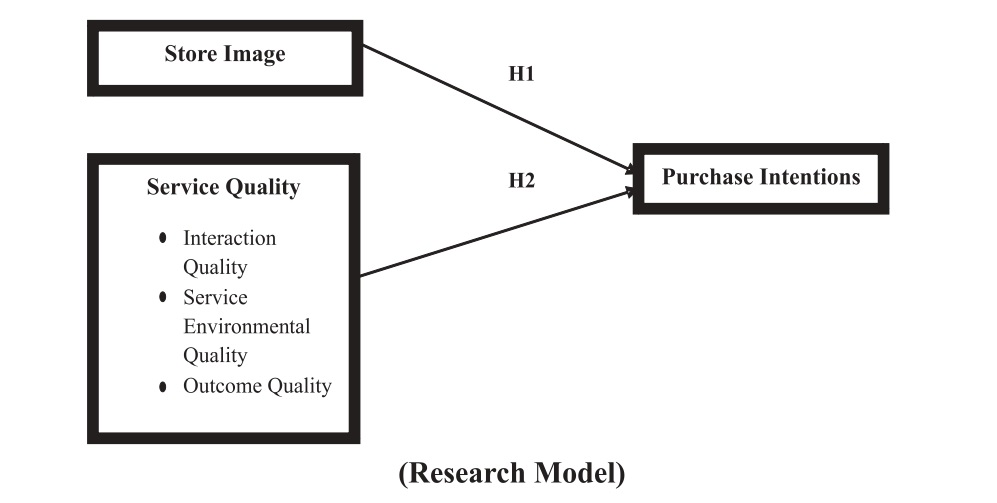
To measure causal impact of store image and servicequality (interaction quality, service environment quality and outcome quality) on purchase intentions, a quantitative research was done in Armed force operated canteen stores departments. Population of the study was customers whowere shopping from Armed force operated canteen stores outcome quality were adapted from Brady et al., (2002). departments at Lahore city. Sample of the study were 450 Three items to measure purchase intentions were taken customers. Cross sectional survey strategy was used to from Erdem, Swait, & Valenzuela, (2006) and Buil, gather primary data from respondents with the help of Martínez, & Chernatony,(2013). Five point likert scales questionnaire through convenience sampling method.
To measure the constructs of this study, questionnaire was adapted from different past studies. To measure store Lindley, (2003). Service quality was measured by using and outcome quality) on purchase intentions, a quantitative interaction quality, service environment quality and research was done in Armed force operated canteen stores outcome quality. For this purpose six items to measure departments. Population of the study was customers who interaction quality, service environment quality and were shopping from Armed force operated canteen stores outcome quality were adapted from Brady et al., (2002). departments at Lahore city. Sample of the study were 450 Three items to measure purchase intentions were taken customers. Cross sectional survey strategy was used to from Erdem, Swait, & Valenzuela, (2006) and Buil, was utilized on all constructs' items. Scales were chosen to customers. 309 questionnaires were completed in all fit the setting of the review. respects indicating the response rate of 69%.
Total 490 questionnaires were distributed among customers. 309 questionnaires were completed in all fit the setting of the review. respects indicating the response rate of 69%. Results and Analysis: Demographic characteristics of respondents were scrutinized using SPSS 23
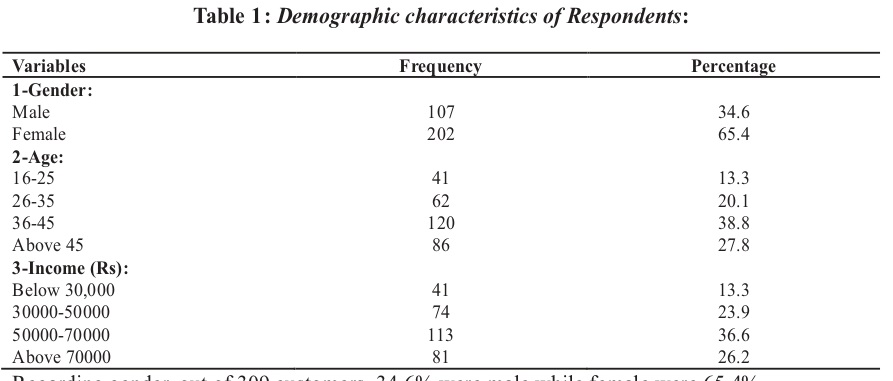
Regarding gender, out of 309 customers, 34.6% were male while female were 65.4%. From the age perspective, 36-45 had highest percentage of 30000-50000 had income level of 23.9% and below 30,000 38.8 while age group of 16-25 had lowest percentage of had income level of 13.3 %. 13.3. Considering income level, 50000-70000 had highest Descriptive Statistics of the study were measured using percentage of 36.6, above 70000 had percentage of 26.2, SPSS 23(Table 2)
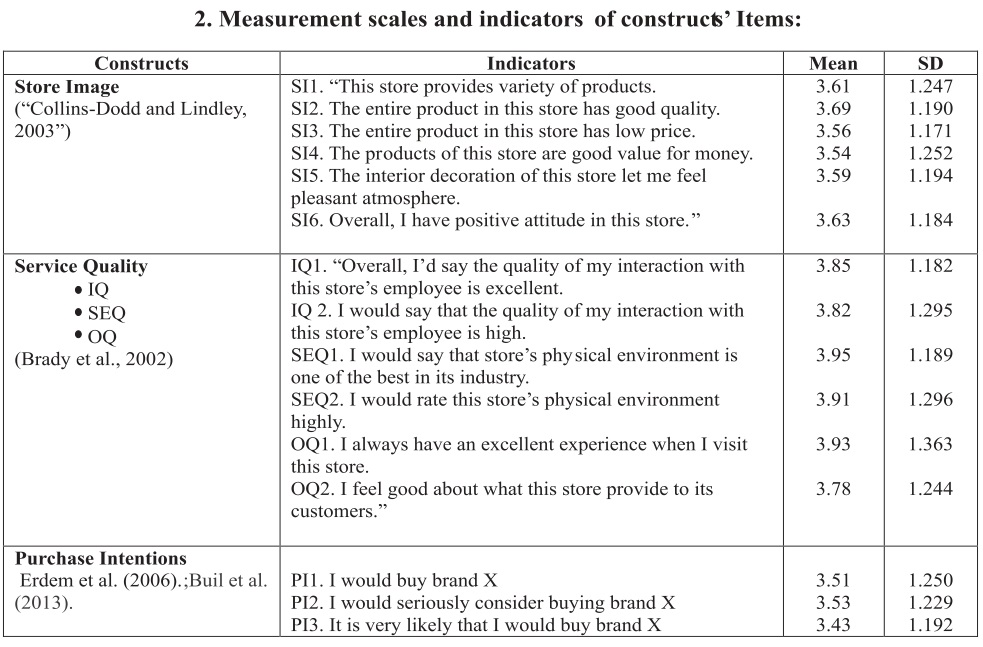
reliability qualities more prominent than 0.70 are middle of the road, while values lower than 0.70 indicate an Confirmatory factor analysis was conducted using AMOS inadequacy in interior consistency. Table 2 showed that the 23.Figure 2 showed study measurement model. Reliability Cronbach's alpha and composite reliability for all of the scale's constructs was measured using cronbach's constructs outperformed the edge estimation of 0.70, in this alpha and composite reliability. Hair, Ringle, & Sarstedt, way setting up solid reliability among the measures. (2011) noticed that Cronbach's alpha and composite
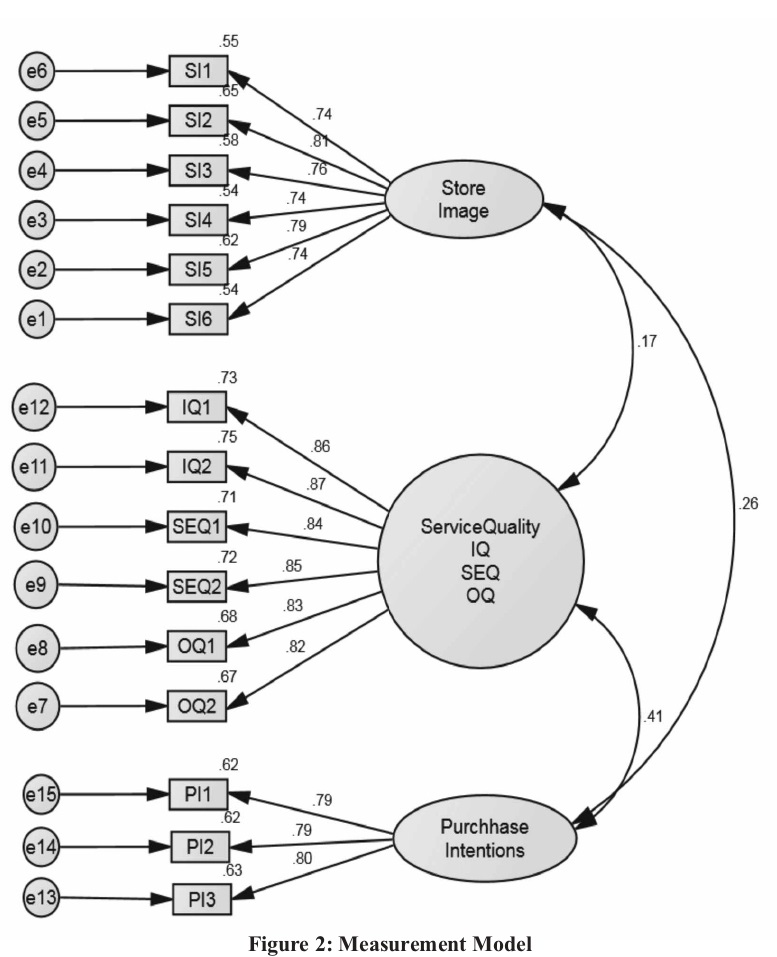
To test confirmatory factor analysis, both convergent and bring down breaking point of 0.50 (Fornell & Larcker, discriminate validity have been performed. Convergent 1981). All tests bolster the convergent validity of the scales validity is accessed with standardized factor loadings and AVE. Results indicated that standardized factor loadings are highly significant. AVE values surpass the suggested (Table 2).
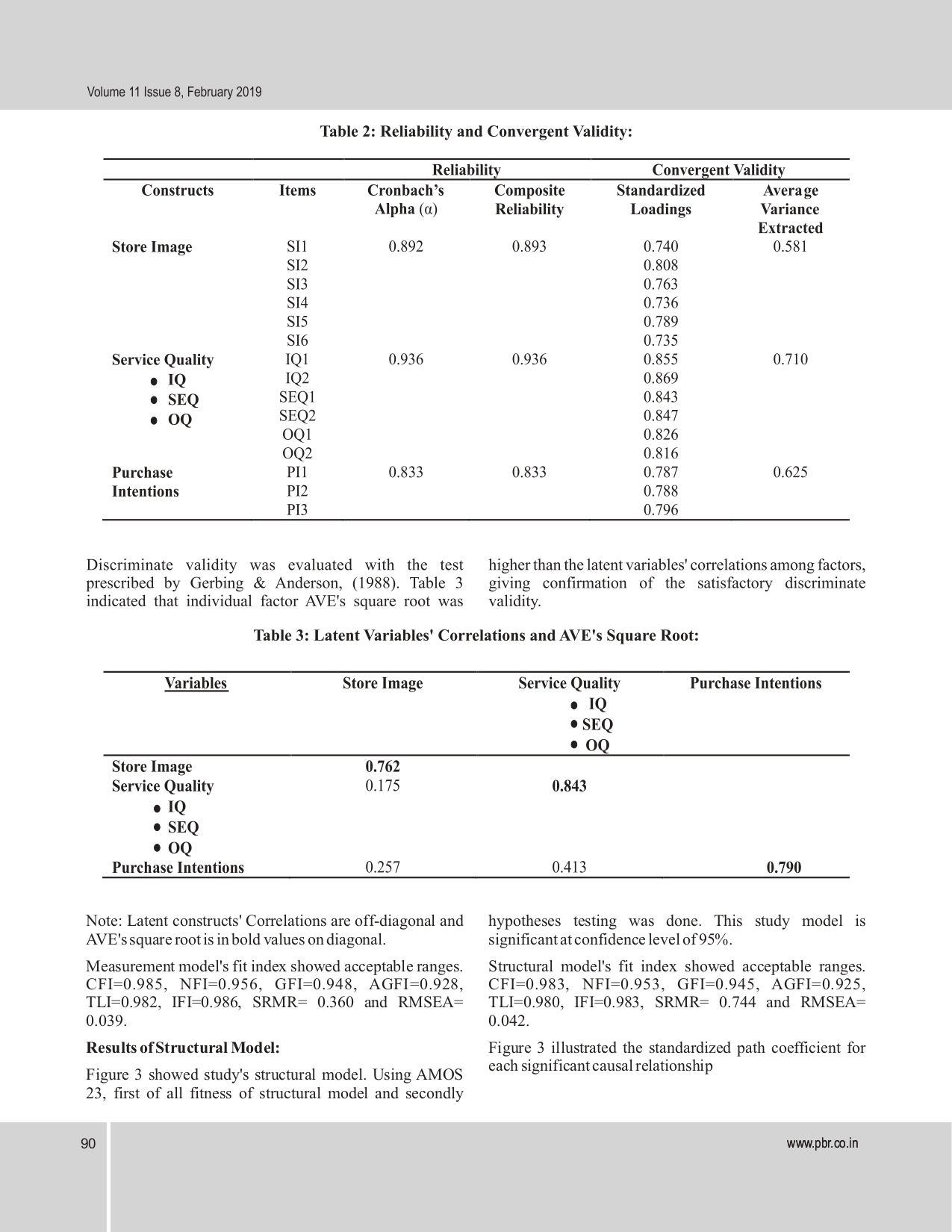
Note: Latent constructs' Correlations are off-diagonal and hypotheses testing was done. This study model is AVE's square root is in bold values on diagonal. significant at confidence level of 95%. Measurement model's fit index showed acceptable ranges. Structural model's fit index showed acceptable ranges. CFI=0.985, NFI=0.956, GFI=0.948, AGFI=0.928, CFI=0.983, NFI=0.953, GFI=0.945, AGFI=0.925,
Figure 3 showed study's structural model. Using AMOS 23, first of all fitness of structural model and secondly Figure 3: Structural ModelTLI=0.980, IFI=0.983, SRMR= 0.744 and RMSEA= 0.042. Figure 3 illustrated the standardized path coefficient for each significant causal relationship
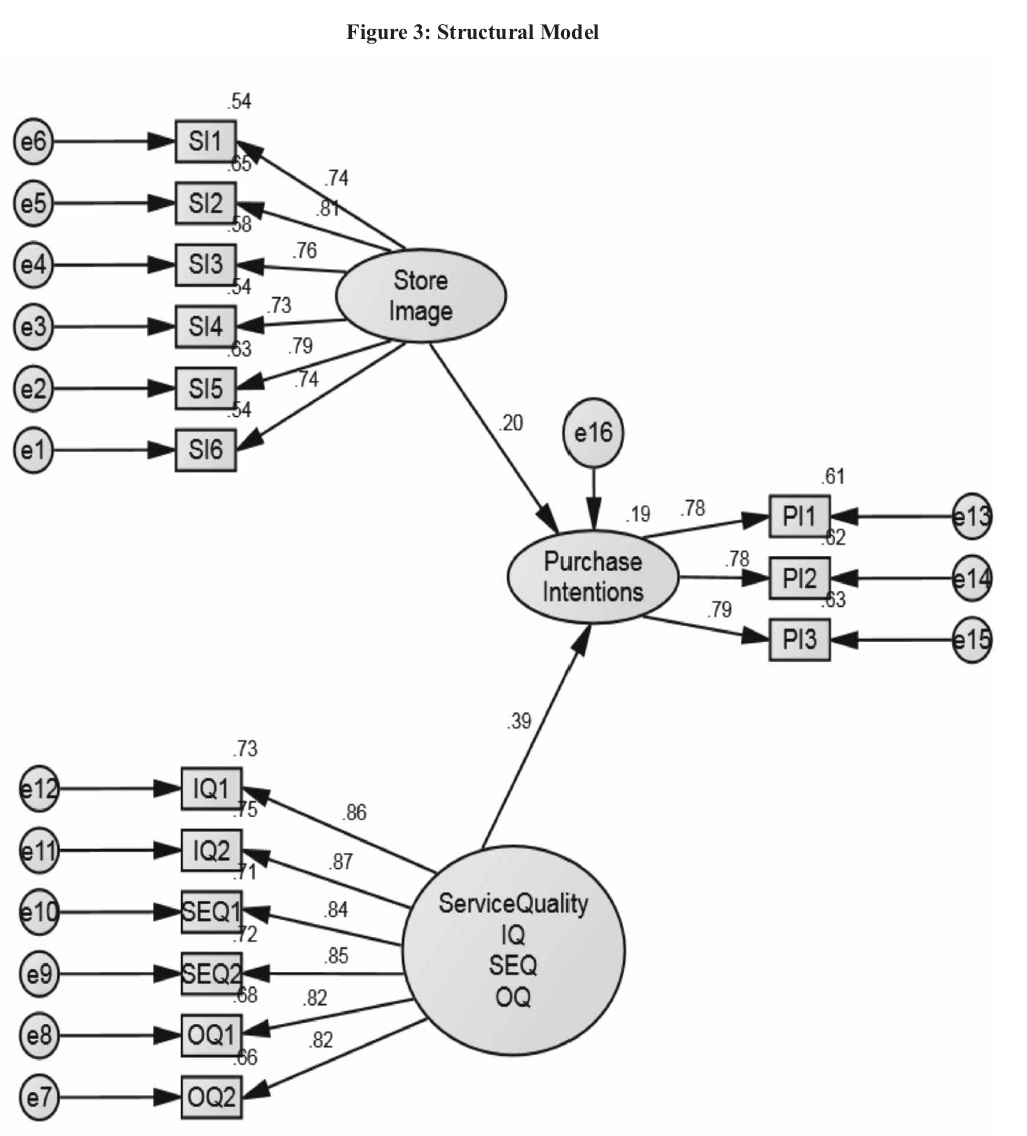
Results of hypothesized relations demonstrated that every p=***) were found to have significantly positive relation one of the two hypotheses was upheld (Table 4). Store with purchase intentions. Image (â=0.197, p=0.002), Service quality (â=0.387,

The purpose of this research study was to find out the impact of store image and service quality (interaction quality, service environment quality and outcome quality) on customer purchase intentions. Store image and service quality were exogenous variables of the study while purchase intentions was endogenous variable. Table 5 demonstrated standardized path coefficient and p- value of all two hypotheses. Hypothesis H1 was supported as it has standardizes path coefficient of 0.197 with the p-value of 0.002 therefore the relationship among store image and purchase intentions is significant and positive. The result of this study is consistent with the work of previous studies (Wu, Yeh, & Hsiao, 2011; Das, 2014a, 2014b). Hypothesis H2 was also supported as its standardized path coefficient value is 0.387 and p value is highly significant. Service quality had strongest impact on purchase intention and relationship among both factors is significantly positive. Result of the study is consistent with the work of Hardjanti, (2011), who investigated the impact of service quality along with its dimensions on purchase intentions for telecommunication services and found significant influence of service quality on purchase intentions. Considering every single above outcome, it is apparent that every exogenous variable are of high-need to enhance purchase intentions of the customer in Armed force operated canteen stores department. The empowering finding of this review contributes towards the progression in existing assortment of learning as it researched the impact of service quality along with its dimensions on purchase intentions of customers in Armed forces canteen store department. Considering results, customers of Armed forces canteen store department are more influenced by service quality and it had strongest impact on purchase intentions of customers. It showed that great and high caliber of communication of store's employees, best physical condition of store, and incredible involvement with store brings about high intentions to purchase. As to, management of Armed forces canteen store department ought to give careful consideration on nature of quality as well as there is a need to prepare and teach the staff on the best way to cooperate with customers proficiently. By concentrating on store image and service quality, Armed force canteen store departments can propagate a solid aggressive position in retail store industry.
This research study is constrained in a few regards. First of all this study focused on Armed forces canteen store departments. In future researchers can consider different retail stores such as hyperstar and emporium mall etc. Researchers can also implement this model in different sectors such as banking sector to find out generalizability of the results. This study is taken place in Lahore, Pakistan.
Convincingly, various remarkable focuses are highlighted in this review and important recommendations are given for managers. One of the vital commitments of the review is that it highlighted the image of Armed forces canteen store departments and discover store image as one of the vital component which would affect on purchase intentions of the customers. Concerning, administrators ought to give careful consideration on assortment of items, great quality, low costs, and inside embellishment of Armed forced canteen store departments. In future, researchers can select different cities of Pakistan. Another limitation of this review is that this research study is cross sectional in nature. In future, researchers can require time series data. This investigation study is confined to two variables namely store image and service quality. Diverse factors, for instance, relative low price and reputation can be joined into future looks into with a particular ultimate objective to recognize their effect on purchase intentions of consumers
Intentions. A Study of Retail Stores in orientation & promotion, project management Pakistan. effectiveness, and the task-technology- Azad, N., & Ahmadi, F. (2015). The customer relationship management process: its measurement and structure fit. Journal of Computer information systems, 48(2), 1-15. impact on performance. Uncertain Supply Chang, E.-C., & Tseng, Y.-F. (2013). Research note: E- Chain Management, 3(1), 43-50. store image, perceived value and perceived Baker, J., Parasuraman, A., Grewal, D., & Voss, G. B. (2002). The influence of multiple store risk. Journal of Business Research, 66(7), 864-870. environment cues on perceived merchandise Chen, M.-Y., & Teng, C.-I. (2013). A comprehensive model value and patronage intentions. Journal of of the effects of online store image on Marketing, 66(2), 120-141. purchase intention in an e-commerce Bansal, H. S., & Taylor, S. (2015). Investigating the relationship between service quality, environment. Electronic Commerce Research, 13(1), 1. satisfaction and switching intentions. Paper Cheung, R., & Woo, M. (2016). Determinants of Perceived presented at the Proceedings of the 1997 Service Quality: An Empirical Investigation Academy of Marketing Science (AMS) of Fitness and Recreational Facilities. Annual Conference. Contemporary Management Research, 12(3), Bansal, H. S., & Taylor, S. F. (2015). Beyond service 363. quality and customer satisfaction: Choudhury, K. (2013). Service quality and customers' investigating additional antecedents of service purchase intentions: an empirical study of the provider switching intentions. Paper Indian banking sector. International Journal of presented at the Proceedings of the 1999 Bank Marketing, 31(7), 529-543. Academy of Marketing Science (AMS) Annual Conference. Chow, I. H.-s., Lau, V. P., Lo, T. W.-c., Sha, Z., & Yun, H. (2007). Service quality in restaurant Basker, E. (2007). The causes and consequences of Wal- operations in China: Decision-and Mart's growth. The Journal of Economic experiential-oriented perspectives. Perspectives, 21(3), 177-198. International Journal of Hospitality
Brady, M. K., Cronin, J. J., & Brand, R. R. (2002). Management, 26(3), 698-710. Performance-only measurement of service Collins-Dodd, C., & Lindley, T. (2003). Store brands and quality: a replication and extension. Journal of retail differentiation: the influence of store Business Research, 55(1), 17-31. image and store brand attitude on store own Buil, I., Martínez, E., & de Chernatony, L. (2013). The influence of brand equity on consumer brand perceptions. Journal of Retailing and Consumer Services, 10(6), 345-352. responses. Journal of consumer marketing, Das, G. (2014a). Impact of store image on store loyalty and 30(1), 62-74. purchase intention: does it vary across gender? Calvo Porral, C., & Lang, M. F. (2015). Private labels: The role of manufacturer identification, brand International Journal of Electronic Marketing and Retailing, 6(1), 52-71. loyalty and image on purchase intention. Das, G. (2014b). Linkages of retailer awareness, retailer British Food Journal, 117(2), 506-522. association, retailer perceived quality and Carrillat, F. A., Jaramillo, F., & Mulki, J. P. (2009). Examining the impact of service quality: a meta-analysis of empirical evidence. Journal of Marketing Theory and Practice, 17(2), 95- retailer loyalty with purchase intention: a study of Indian food retail brands. Journal of Retailing and Consumer Services, 21(3), 284292. 110. Dawar, N., & Parker, P. (1994). Marketing universals: Chakrabarty, S., Whitten, D., & Green, K. (2008). Understanding service quality and relationship quality in IS outsourcing: Client Consumers' use of brand name, price, physical appearance, and retailer reputation as signals of product quality. The Journal of Marketing, 81-95. Volume 11 Issue 8, February 2019 Dedeke, A. N. (2016). Travel web-site design: Information 52(2), 23-32. task-fit, service quality and purchase intention. Tourism Management, 54, 541-554. Kim, J., & Lennon, S. J. (2013). Effects of reputation and website quality on online consumers' emotion, Erdem, T., Swait, J., & Valenzuela, A. (2006). Brands as perceived risk and purchase intention: Based signals: A cross-country validation study. on the stimulus-organism-response model. Journal of Marketing, 70(1), 34-49. Journal of Research in Interactive Marketing, Fornell, C., & Larcker, D. F. (1981). Structural equation 7(1), 33-56. models with unobservable variables and Kwortnik, R. J. (2008). Shipscape influence on the leisure measurement error: Algebra and statistics. cruise experience. International Journal of Journal of Marketing Research, 382-388. Culture, Tourism and Hospitality Research, Gerbing, D. W., & Anderson, J. C. (1988). An updated 2(4), 289-311. paradigm for scale development incorporating Lai, F., Griffin, M., & Babin, B. J. (2009). How quality, unidimensionality and its assessment. Journal value, image, and satisfaction create loyalty at of Marketing Research, 186-192. a Chinese telecom. Journal of Business Hair, J. F., Ringle, C. M., & Sarstedt, M. (2011). PLS- Research, 62(10), 980-986. SEM: Indeed a silver bullet. Journal of Lee, G.-G., & Lin, H.-F. (2005). Customer perceptions of Marketing Theory and Practice, 19(2), 139- e-service quality in online shopping. 152. International Journal of Retail & Distribution Hamari, J., Hanner, N., & Koivisto, J. (2017). Service Management, 33(2), 161-176. quality explains why people use freemium Liang, T.-P., & Lai, H.-J. (2002). Effect of store design on services but not if they go premium: An consumer purchases: an empirical study of on- empirical study in free-to-play games. line bookstores. Information & Management, International Journal of Information 39(6), 431-444. Management, 37(1), 1449-1459. Lien, C.-H., Cao, Y., & Zhou, X. (2017). Service quality, Han, X., Kwortnik Jr, R. J., & Wang, C. (2008). Service satisfaction, stickiness, and usage intentions: loyalty: An integrative model and An exploratory evaluation in the context of examination across service contexts. Journal WeChat services. Computers in Human of Service Research, 11(1), 22-42. Behavior, 68, 403-410. Hardjanti, A. (2011). Peran Interaction, Physical Lien, C.-H., Wen, M.-J., Huang, L.-C., & Wu, K.-L. (2015). Environment dan Result Quality Terhadap Online hotel booking: The effects of brand Purchase Intention dan Word Of Mouth. image, price, trust and value on purchase Ilmiah Manajemen Bisnis, 11(1). intentions. Asia Pacific Management Review, Hsu, M.-H., Chang, C.-M., & Chuang, L.-W. (2015). 20(4), 210-218. Understanding the determinants of online Loo, C. L., Chua, S. F., Foong, H. Z., Loke, K., & Pang, E. repeat purchase intention and moderating role C. (2016). Service Quality on Behavioural of habit: The case of online group-buying in Purchase Intentions in the Public Land Taiwan. International Journal of Information Transportations Service in Kuala Lumpur, Management, 35(1), 45-56. Malaysia. UTAR. Huang, C.-C., Yen, S.-W., Liu, C.-Y., & Huang, P.-C. Martineau, P. (1958). The personality of the retail store. (2014). The relationship among corporate social responsibility, service quality, corporate image and purchase intention. International Journal of Organizational Innovation (Online), 6(3), 68. Nguyen, N., & Leblanc, G. (2002). Contact personnel, physical environment and the perceived corporate image of intangible services by new clients. International Journal of Service Industry Management, 13(3), 242-262. James, D. L., Durand, R. M., & Dreves, R. A. (1976). Use Of A Multi-Attribute Attitude Model In A Store Image Study. Journal of Retailing, Peters, C., & Thomas, J. (2017). Dr. Shopping, Her Business Partner, and the New Retail Store Experience. Journal of the International Su, L., Swanson, S. R., & Chen, X. (2016). The effects of perceived service quality on repurchase
Academy for Case Studies, 23(1), 30. intentions and subjective well-being of Ranganathan, C., & Ganapathy, S. (2002). Key dimensions of business-to-consumer web sites. Information & Management, 39(6), 457-465. Chinese tourists: The mediating role of relationship quality. Tourism Management, 52, 82-95. Reinartz, W., Krafft, M., & Hoyer, W. D. (2004). The customer relationship management process: Its measurement and impact on performance. Journal of Marketing Research, 41(3), 293- Szymanski, D. M., & Henard, D. H. (2001). Customer satisfaction: A meta-analysis of the empirical evidence. Journal of the academy of marketing science, 29(1), 16-35. 305. Wall, E. A., & Berry, L. L. (2007). The combined effects of Richard, M.-O., & Chandra, R. (2005). A model of consumer web navigational behavior: conceptual development and application. Journal of Business Research, 58(8), 1019- the physical environment and employee behavior on customer perception of restaurant service quality. Cornell Hotel and Restaurant Administration Quarterly, 48(1), 59-69. 1029. Wu, P. C., Yeh, G. Y.-Y., & Hsiao, C.-R. (2011). The effect Ryu, K., Lee, H.-R., & Gon Kim, W. (2012). The influence of the quality of the physical environment, food, and service on restaurant image, customer perceived value, customer of store image and service quality on brand image and purchase intention for private label brands. Australasian Marketing Journal (AMJ), 19(1), 30-39. satisfaction, and behavioral intentions. Xie, D., & Heung, V. C. (2012). The effects of brand International Journal of Contemporary relationship quality on responses to service Hospitality Management, 24(2), 200-223. failure of hotel consumers. International Schiffman, L. G., & Kanuk, L. L. (2007). Consumer Behavior. Its Origins and Strategic Journal of Hospitality Management, 31(3), 735-744. Applications. Consumer Behavior. 9th Yang, S., Lu, Y., Chau, P. Y., & Gupta, S. (2017). Role of Edition. Upper Saddle River: Pearson channel integration on the service quality, Education Inc, 2-4. satisfaction, and repurchase intention in a Soltani, M., Esfidani, M. R., Jandaghi, G., & Soltaninejad, N. (2016). The effect of service quality on private brand image and purchase intention in multi-channel (online-cum-mobile) retail environment. International Journal of Mobile Communications, 15(1), 1-25. the chain stores of ETKA. World Scientific Zhu, T., Singh, V., & Manuszak, M. D. (2009). Market News, 47(2), 202. structure and competition in the retail discount industry. Journal of Marketing Research, 46(4), 453-466